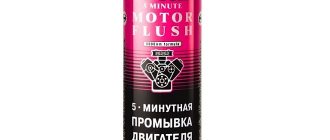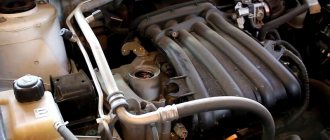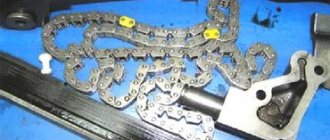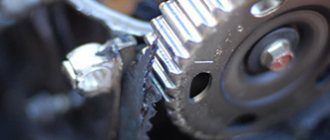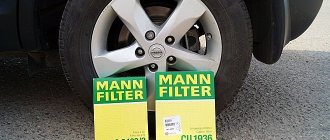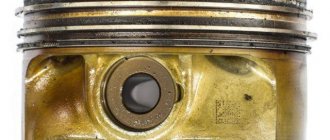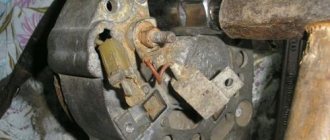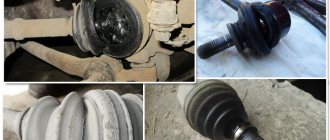Getting rid of dirt
Dirt in the gas tank does not bode well; at any moment it can clog the fuel system and immobilize the car. In order to properly clean the gas tank, it had to be removed from the car, and this is a rather labor-intensive and time-consuming process. But there are easier ways to get rid of dirt without removing the gas tank from the car.
To clean the tank, we will need a platform, a simple set of tools and a can of gasoline, since after cleaning there will be no gasoline left in the tank. We drive the car onto the overpass and unscrew the drain plug at the bottom of the gas tank; there is such a plug on any tank. We place a container in advance for the gasoline to be drained; along with it, some of the dirty slurry from the bottom of the tank will drain.
Next, remove the cushion from the rear seat and find the fuel pump under it. We disconnect the wires from it, then you need to carefully unscrew it from the gas tank and remove it. At the same time, you can inspect the fuel filter on the pump and, if necessary, replace it with a new one. By removing the fuel pump, we get a large hole through which you can clean the inside of the tank. This can be done with a non-lint rag. Having finished cleaning, we put everything back together in the reverse order and fill the gasoline from the canister.
How to flush the gas tank without removing it from the car
Completely flushing a car's gas tank is a rather labor-intensive but effective procedure. If you don’t have time to do it, but you need to clean the gas tank of accumulated contaminants, you can perform express cleaning without removal, which is much less effective. You can clean the gas tank without removing it from the car as follows:
- You need to unscrew the drain bolt on the bottom of the gas tank and pour the remaining fuel into a plastic container;
- Next, you need to tighten the drain bolt and take 2-3 liters of good, clean gasoline. Pour it into the car tank;
- After this, start rocking the car left and right so that the gasoline can wash away all the dirt from the walls of the gas tank;
- Drain the gasoline used for washing and fill in new 2-3 liters of gasoline to repeat the procedure;
- After draining the gasoline again, close the drain plug and clean the gas tank using compressed air.
At this point, the washing can be considered complete. As mentioned above, cleaning the gas tank without removing it from the car is ineffective. The benefit of it largely depends on the design of the gas tank itself and the degree of contamination.
We expel water from the tank
You can get rid of water accumulated in the gas tank without removing or unscrewing anything. To do this, we will need a small amount of any alcohol or acetone, as well as a canister of gasoline. It is especially useful to “dry” the tank of water before the start of winter, so that in severe frosts it does not freeze in the fuel system. Before you put anything into the tank, it must be almost completely empty. Add alcohol or, in extreme cases, acetone to the remaining gasoline at the rate of 10 ml per liter of fuel. The water in the tank will mix with the alcohol and evaporate along with it. Next, you need to drive until the gas tank is empty and the car stalls. We refuel from the canister and you can safely move on.
A fuel tank is a container in which fuel is stored. To ensure that gasoline storage is as safe as possible, modern tanks are made of durable metal alloys and treated with anti-corrosion substances. However, during operation, the cavity and surfaces of the gas tank are inevitably susceptible to rust - in this case, the car owner must take the necessary measures to extend the life of the tank.
Removing water
Water is the main enemy of a gas tank. It is this that causes rust to appear on the walls of the tank, which in the future can cause it to leak. Therefore, it is important to periodically remove water from the container, since it is impossible to completely prevent it from getting inside.
Sudden temperature changes in the cold season, low-quality gasoline - all this leads to the accumulation of moisture in the fuel tank. Therefore, it is important to remove it from the tank before frost sets in so that it does not turn into ice and interfere with the supply of gasoline.
This can be done by adding ethyl alcohol 95% to the remaining fuel in a ratio of 10 ml per 1 liter of gasoline. It is recommended to do this when there is no more than 5 liters of fuel left in the tank.
While driving, the water will mix with alcohol and burn off. The main thing is not to add fuel to the tank until the mixture is finished. Afterwards the car is refueled in the usual way.
The gas tank is a kind of stomach of the vehicle, which affects its operation. For this reason, it is important to monitor the condition of the tank, preventing it from becoming dirty, getting water in, or causing rust.
Many drivers notice something wrong with their car when the engine speed suddenly drops or increases. Most blame this on careless fuel sellers who sell low-quality goods. However, the reason may be different: trapped dirt blocks the operation of fuel injection. To normalize it, you need to rinse the gas tank from rust and other deposits.
Causes and signs of gas tank contamination
Many car enthusiasts don’t even think about the fact that the insides of the gas tank may need to be flushed or cleaned. Indeed, this is a completely closed container, where does dirt or dust come from?
However, the older the car, the more clogged the fuel tank becomes. And this can be blamed on several factors:
Tank service life - during operation, rust forms inside a metal container under the influence of temperatures.
Using low-quality fuel, which contains large amounts of dirt and sediment.
Failure to use cleaners to remove impurities from all elements of the fuel system.
The gas tank cap allows you to safely pour fuel through the filler pipe into the tank container
The main sign of a dirty fuel tank can be considered jerks in engine operation at low speeds. Water and impurities in gasoline prevent the engine from using all its intended power, so at low speeds the car begins to twitch.
When to clean the fuel tank
Cleaning and flushing the fuel tank is a prerequisite for its reliable operation. However, it is not recommended to wash it too often. The procedure can be performed once every two or three years, it all depends on the operating conditions and the quality of the fuel being poured.
If the car is constantly refueled at questionable gas stations on the highway, it is recommended to clean the tank capacity once a year. This will save the fuel filters from quickly depleting and eliminate the possibility of the lines becoming clogged with dirt and impurities.
For the entire fuel system (including the gas tank), the use of high-quality fuel is considered an important operating factor.
Actually, cleaning the gas tank is necessary to ensure high-quality operation of all elements of the fuel supply system. After all, small particles of sediment and impurities can enter the engine through the tank, which can lead to serious damage.
Flushing the gas tank after dismantling it
To better clean the fuel tank from all kinds of deposits, it must be removed. This is quite easy to do on almost any car; the main thing is to read the technical operating instructions for the car and clearly understand its design. There are several ways to flush the gas tank in this way:
- Using soda;
- Using electrolysis;
- Using phosphoric acid;
- Cleaning the gas tank with nuts.
Using soda as a cleaning agent is quite expensive, but very effective in practice. Expensive soda is heated to 40 degrees and poured into the gas tank to the brim. After keeping the soda in the gas tank for several hours, it is drained and thereby completes the flushing. The use of the electrolysis method is considered extremely effective. During this process, rust is removed from the gas tank and the metal layer is restored. This method is based on chemical electrolysis, which results in the formation of gases and water. The simplest method is considered to be using phosphoric acid. The substance is poured into the gas tank and wait 25 minutes. Then they drain and check the final result. If necessary, the procedure is repeated. The oldest method of cleaning a gas tank is the nut method. It is recommended to use it only if the entire surface of the gas tank is covered with a thick layer of rust.
The video will tell you how to flush the fuel tank yourself:
Service rarely includes cleaning the fuel tank. The driver must monitor this himself. This is probably why gas tanks are used in a dirty state until serious problems arise in the operation of the car. Eliminating them will be more expensive and more difficult than cleaning the fuel tank in a timely manner.
Cleaning methods
Different brands of cars have different fuel tanks. The easiest cleaning method will be on those models whose gas tanks have a drain hole. That is, draining fuel and washing can be done without dismantling the tank.
However, this option is not available to most car enthusiasts, so you will have to remove the tank from the car and wash it separately.
Preparatory stage
The procedure for flushing the gas tank is best done in the fresh air or in a well-ventilated area. Working with flammable and strong-smelling substances can affect a person’s well-being.
The fuel tank must be removed from the car body. As a rule, this procedure does not take much time. The main thing is to use up the entire volume of fuel available in the tank in advance, so that you do not have to drain the gasoline. However, in any case, several liters of fuel will remain in the system - both in the tank itself and in the fuel lines. Therefore, you will need to disconnect the connectors from the fuel pump, and also remove the hoses from the tank itself. You can place fuel drainage containers under all connection points so that fuel does not go into the ground or into half the garage.
When dismantling the gas tank, some amount of fuel will inevitably spill, so it is recommended to use both containers for drainage and rags
After the gas tank is removed from the car, you need to open all its holes and drain the remaining fuel.
Various cleaning products
A variety of products are used to clean gas tanks. All of them are freely available and inexpensive. Depending on the cleaner used, the cleaning method will vary.
Is it possible to flush the tank with gasoline?
Washing with gasoline (diesel fuel) is a mandatory step in all cleaning procedures. The fact is that after any, even the most thorough washing, a small amount of acid, acetone or washing powder inevitably remains in the gas tank. You cannot install such a tank on a car, because all this sediment will get into the fuel system, and from it into the engine.
Before pouring gasoline, it is recommended to dry the tank with a hairdryer - warm air will quickly dry all corners of the gas tank cavity. It will take a day or more for the container to dry on its own.
Therefore, after completing all cleaning procedures, it is necessary to carry out the last one - rinse the tank with fuel:
Reinstall the tank.
Connect all necessary lines.
Fill the gas tank to the brim with gasoline.
Start the engine and allow the fuel to circulate through the system.
Add gasoline as it leaves the highways.
Video: an alternative method of flushing gas tanks
It is very important to fill the tank full immediately, and it is not recommended to use fresh gasoline for this purpose. It is better to prepare cans of fuel in advance so that any sediment remains at the bottom.
Preventing rust in the gas tank
After flushing his gas tank, the car owner begins to think more seriously about how to protect this element of the fuel system from rust formation and dirt getting inside. After all, in car maintenance, it is prevention that plays a big role, and not the repair itself.
There are several fairly simple ways to maximize the life of your gas tank without resorting to frequent cleaning:
Fill with known high-quality fuel, which contains a minimum of sediments and impurities.
At gas stations, immediately fill the tank full so that there is no room left for the concentration of moist air in its cavity.
In winter, it is recommended to use dehydrators that will displace water from fuel. Dehydrators come in a variety of forms and are simply added to gasoline through the gas tank.
Periodically, both in summer and winter, use gasoline cleaners by pouring them into the cavity of the fuel tank. This measure has a good effect not only on rust prevention, but also on the entire condition of the car’s fuel system.
Another common way to protect a tank is to cover its surfaces with mastic. Mastic works well to protect metal from corrosion, but the paint itself is not cheap.
Coating with mastic will protect the gas tank from rust for a long time
You can replace the metal tank with a plastic one. In this case, the problem of rust can be avoided, but there will be a risk of other damage - cracks and deformations. In addition, plastic gas tanks, even if there are no defects, last much less than metal ones.
Thus, the condition of the fuel tank depends entirely on the care of the car owner. If you refuel at proven gas stations and periodically flush the tank, then in the future you will not have to buy a new product.
Sources of pollution and combating them
The gas tank is the starting point in the movement of fuel through the vehicle's systems. However, in its depths, in addition to gasoline, you can sometimes find something that shouldn’t be there. Contamination of the tank can lead to impure fuel, and sometimes no fuel at all, entering the engine, and this can lead to serious damage. Signs of a dirty gas tank are:
- problems starting the engine after parking,
- uneven engine operation,
- frequently clogged injectors and fuel filters.
One of the main threats to a car’s fuel system in general and the gas tank in particular is water. It gets into the gas tank with diluted gasoline at dubious gas stations, but even if you fill your car with exclusively high-quality fuel, you are not insured against water in the tank.
It's no secret that the air contains moisture. If the tank is not completely filled with gasoline, then the remaining part is filled with air. When the temperature changes, condensation occurs and moisture from the air collects into water droplets. Do not forget that water is heavier than gasoline, so when it gets into the fuel, it settles to the bottom of the tank, from where it enters the gasoline pump.
Water can cause serious damage to a car, especially in winter when it freezes and interferes with the flow of gasoline to the engine. Both the fuel line and the injection system may be affected. In addition, the accumulation of water in the gas tank leads to corrosion of the inner surface of the gas tank.
Due to its greater density, water settles to the bottom of the vessel, and gasoline rises to the top
Removing water with alcohol
To remove water from gasoline, you need to add half a liter of pure alcohol to a whole tank of gasoline. Alcohol can be ethyl, methyl, isopropyl. It is important that it is pure and not diluted. When alcohol is dissolved in water, a mixture is formed that burns in the engine without problems. If your car has a diesel engine, instead of alcohol you need to add 500 ml of engine oil per 50 liters of diesel fuel. It is worth understanding that this is a one-time measure, and it is best to add alcohol or oil to the gas tank once before the onset of cold weather.
Draining and drying
If there is a drain hole at the bottom of the gas tank, the water can be drained from the fuel. After this, the gas tank can be rinsed from dirt and dried with a hair dryer. Thorough drying is extremely important.
Water can also be drained through the fuel rail. For this:
- Unscrew the nipple cap and attach the water drain hose.
- Connect the pump through the diagnostic block.
- Drain the water.
On most vehicles, the fuel rail is attached to the intake manifold.
Dehumidifiers
Automotive chemical stores always have a wide range of products for removing moisture from the gas tank. Most of them work on the same principle as alcohol. However, some contain aggressive reagents that can accelerate corrosion of the tank walls. You should choose the product very carefully.
Dirt, suspended matter, sediment
In addition to water, you can find a cloudy sediment in the gas tank, which is the remains of gasoline impurities, as well as dirt. Contamination of the fuel tank leads to rapid clogging of the fuel filters and wear of the fuel line as a whole. To clean the tank from dirt and suspended matter, it must be washed with soapy water or a cleaning agent.
Dust, dirt and impurities from low-quality fuel collect as a cloudy sediment at the bottom of the tank
Step-by-step instructions for cleaning the gas tank from dirt and debris
Clean the gas tank in the following sequence:
- Remove the tank and drain the fuel. If your car's gas tank has a drain hole, you do not have to remove the tank, but this may reduce the effectiveness of the procedure.
- Pour soap solution or cleaning agent through the neck. You can use water under high pressure.
- Shake the tank so that all its walls are washed. If the tank is not removed, rock the car.
- Drain the solution. And repeat this procedure several more times until you achieve cleanliness.
- Pour five liters of gasoline into the gas tank and shake it.
- Drain the gasoline.
- Dry the tank. For effective drying, use a technical hair dryer. There should not be a drop of water left in the tank.
Rust
The presence of water and dirt in the fuel tank leads to the formation of rust on the inner walls of the tank. Corrosion is also facilitated by the abundance of additives that increase the octane number of fuel, as well as the use of aggressive dehumidifiers and other chemicals. Cleaning the gas tank from rust is necessary not only to maintain cleanliness and proper operation of the fuel supply system. In especially severe cases, corrosion of the walls of the gas tank can lead to the formation of leaks and holes with all the ensuing consequences. There are two proven ways to combat rust:
- a combination of mechanical cleaning and chemical treatment;
- electrolysis.
Rust on the inside of the tank can harm the entire fuel system
Let's look at each of them in detail.
Cleaning with water, shot and reagents
Rust flakes and light deposits can be partially washed off with water applied under high pressure. To enhance the effect, experienced car enthusiasts advise placing shot or small nuts in the gas tank. Mechanical cleaning is usually not enough to completely remove rust, so chemical treatment is used in combination with it. Special rust converters are sold in stores, but acetone and acids can also be used for treatment. The most commonly used is phosphoric acid.
Phosphoric acid interacts with rust and separates it from the surface of the tank
Before you start working with reagents, make sure that the room is ventilated and that you have thick rubber gloves. A respirator and safety glasses will be useful.
Then proceed in the following order:
- Remove the gas tank and drain the fuel.
- Fill the tank with 2–3 liters of water. The higher its temperature, the higher the cleaning efficiency.
- If there is a lot of rust, place shot or small nuts in the tank. In this case, it is better to use gasoline or kerosene instead of water.
- Shake the gas tank vigorously.
- Drain the water and repeat the process 2-3 times.
- Dry the tank.
- Pour the reagent into the tank:
- if you are using a rust converter, follow the instructions on the package;
- in the case of orthophosphoric acid, it is worth making a solution at the rate of 100 milliliters of reagent per 1 liter of water;
- When using acetone, a liter will be enough.
- Shake the gas tank thoroughly. It is important that the reagent completely covers the inner surface of the tank.
- Wait 2-3 hours, shaking the tank periodically.
- Rinse the tank with water adding 100 grams of baking soda per 10 liters of water.
- Rinse off any remaining baking soda solution with water.
- Dry the tank thoroughly with a hairdryer.
- Install the gas tank on the car.
- Fill with fresh gasoline.
Getting rid of rust
Corrosion eats away at fuel tanks not only due to moisture. Numerous additives used to increase the octane number of gasoline also contribute to its occurrence. If the stains are not removed in time, you may end up with expensive repairs or replacement of any element of the vehicle’s fuel system, including the fuel tank itself. To prevent serious consequences, you can use one of the effective methods for removing corrosion.
Cleaning with water, shot and reagents
To remove rust particles, use a high-pressure water jet. To enhance the effect, you need to throw small metal objects inside, for example, nuts. In addition, you need to purchase a special rust neutralizer. Acetone, thinner or acid will also work.
All work with chemicals should be carried out in a well-ventilated area or outdoors. It is imperative to use personal protective equipment: respirator, goggles, thick rubber gloves.
The procedure is as follows:
- You need to start by removing any remaining fuel and removing the gas tank.
- Pour 2-3 liters of hot water inside.
- Add shot or other filler.
- Shake the tank.
- Drain and repeat the procedure several times.
- Dry the container.
- Prepare the reagent. If you use a purchased regressor, you must follow the directions on the package. The acid is diluted in the amount of 100 milliliters per 1 liter of water, and acetone will need one liter.
- Shake the tank vigorously and do this several times every 2-3 hours.
- Rinse the tank with a solution of water and baking soda in a ratio of 100 g per liter.
- Treat the inner cavity of the tank with clean water.
- Remove the nuts using a magnetic screwdriver.
- Dry the tank.
- Set it in place. If corrosion stains are found on the outer walls, clean them and paint them.
- Fill with fresh fuel.
This technique is quite effective. However, it takes a lot of time to implement it, and if the tank is severely corroded by rust, you can pierce it through with pellets or burn it in weak spots with acid, so old containers should be cleaned using another method.
Applications of Electrolysis
When electric current passes through a chemical solution, the substance decomposes into its constituent parts. It is this property that is used when cleaning the fuel tank from corrosion using this technique. To carry out the electrical procedure you will need:
- Caustic soda.
- Battery or charger.
- Metal conductor.
- Water.
The room must have a good ventilation system due to the explosiveness of the mixture of hydrogen and oxygen formed as a result of electrolysis. It would be optimal to hold the event outdoors.
It is recommended to steam the tank before starting cleaning. To do this, you can use a steam generator or the traditional method. You need to put a hose on the exhaust pipe, the second end of which is inserted into the neck of the container. Drying should be carried out for 15-20 minutes at idle speed. You can also use this technique when welding cracks in a gas tank.
Electrochemical cleaning should be carried out using thick rubber gloves and avoid getting the solution on exposed skin, since caustic is a strong alkali and causes burns to the body. If you come into contact with this solution, the affected area should be rinsed generously with clean water.
A short guide to electrolysis:
- Mix one glass of caustic soda in 30 liters of water.
- Fill the tank 90 percent with solution.
- Insert the conductor inside to the bottom without touching the walls. You can cut a wooden or plastic plug to fit the diameter of the neck and place this electrode in the middle.
- Connect the wire to the minus of the battery, and the cleaned area of the tank body to the plus.
- In 2-3 days, the internal space will be completely cleaned of traces of corrosion.
- After completing the process, you need to disconnect the battery and remove the electrode.
- Drain the liquid, rinse and dry the tank.
Despite the duration of the procedure, this method is effective and delicate. However, to avoid such hassle, it is easier to prevent the formation of rust.
Preventing gas tank contamination
Cleaning the tank from water, dirt and rust with your own hands is quite simple. However, not every car enthusiast wants to do this. You can, of course, turn to professionals, but it costs money. It is much easier to prevent contamination of the tank and corrosion of its walls.
Epoxy against rust
Epoxy resins are used for anti-corrosion treatment of the inner surface of the gas tank. This coating is insoluble in water and gasoline, making it excellent for rust protection. To evenly apply the resin to all the walls of the tank, it must be poured through the neck, and then rotate the tank for a long time. When the epoxy has spread over all the walls of the tank, you can begin drying.
Anti-corrosion additives
Auto chemical stores sell anti-corrosion fuel additives. Among them there are very effective ones, but there are often cases when additives do not properly protect the gas tank from rust. Before choosing one of them, we recommend reading reviews on the Internet.
Smart car operation
The most reliable way to prevent contamination and corrosion of a gas tank is proper operation of the vehicle. A set of simple rules that, if followed, will save you from having to clean the gas tank:
- Monitor the quality of the fuel. Refuel only at approved gas stations.
- Monitor the amount of fuel. Try to keep the tank full. Be sure to fill it completely before parking for a long time. This will avoid the accumulation of water in the tank and its condensation on the walls.
- Try not to refuel in high humidity or foggy weather. If you still need to refuel, fill the tank full.
- With the onset of cold weather, add desiccant or alcohol to the tank in small quantities.
If a car's engine is its fiery heart, then the gas tank is its stomach, so it is very important for the health of the car to monitor its condition. Keep your tank clean and fill it with only quality gasoline, and your car will reward you with a smooth ride and long service life.
